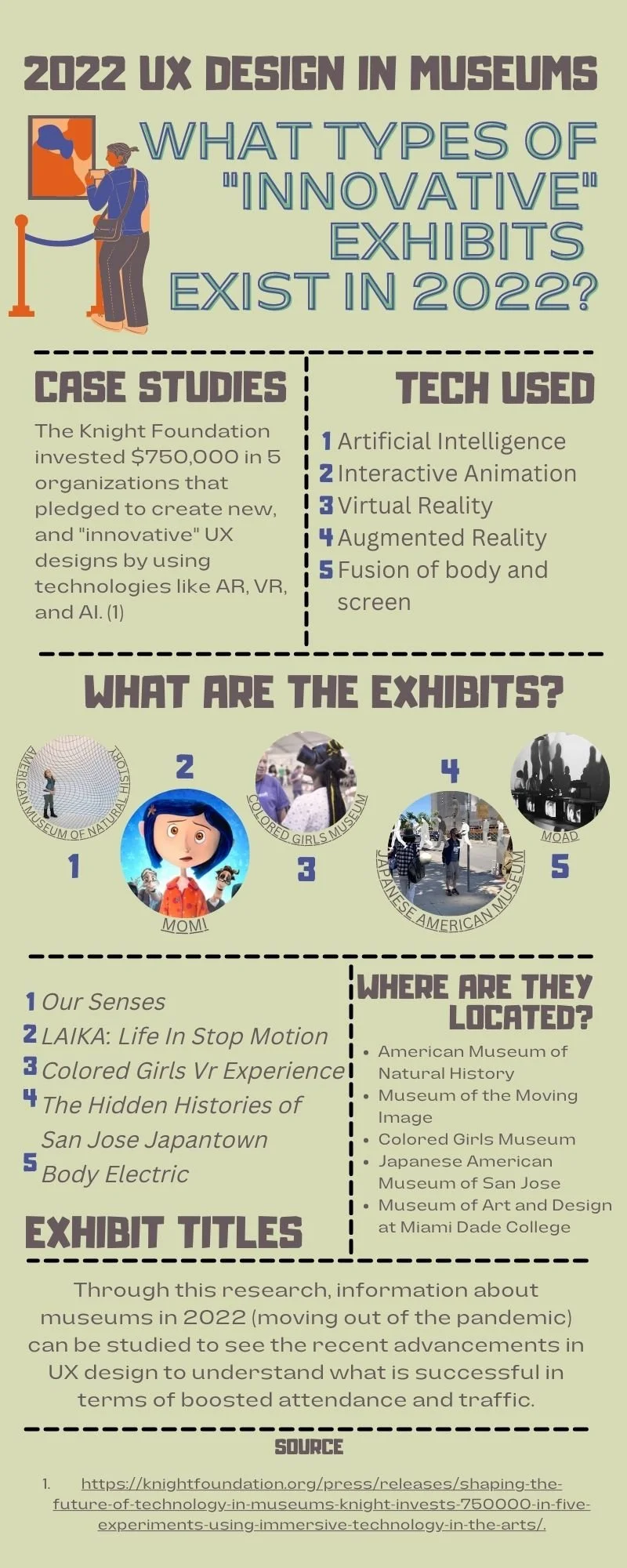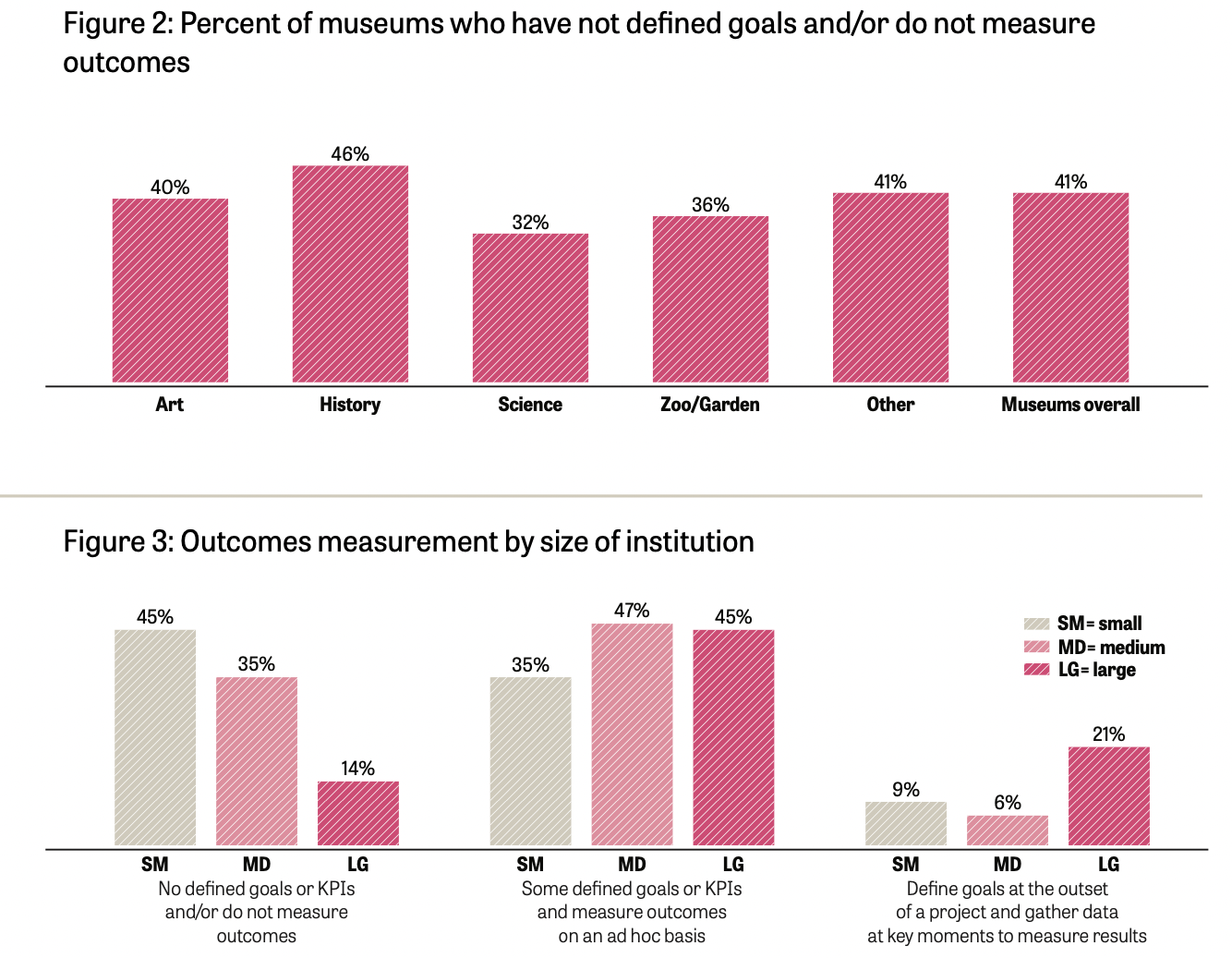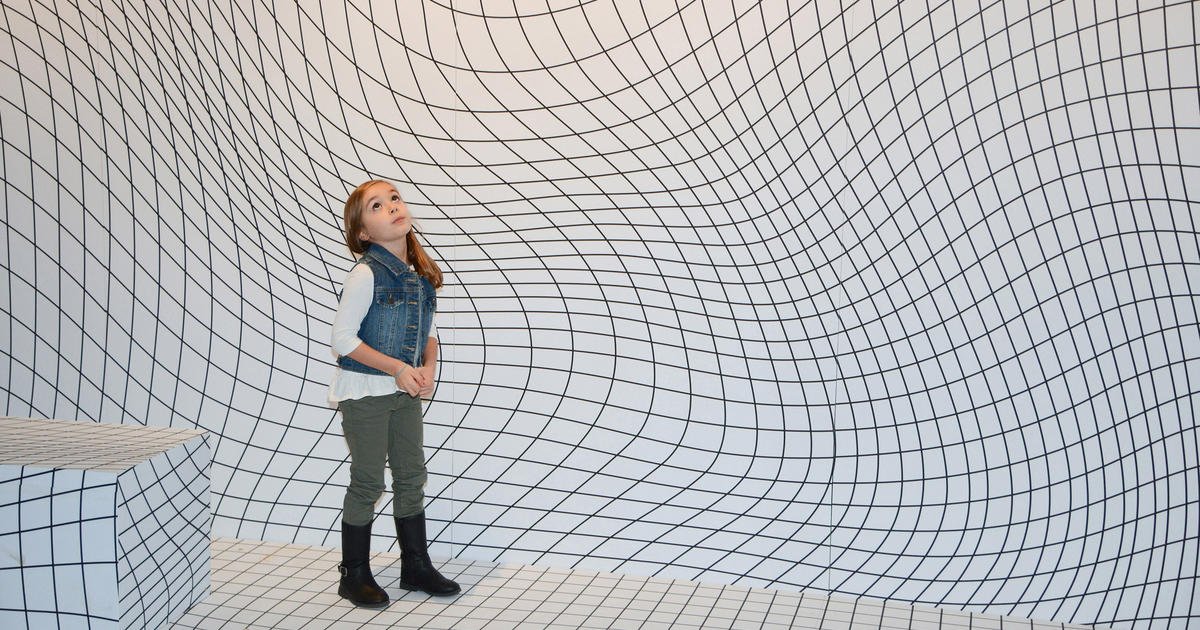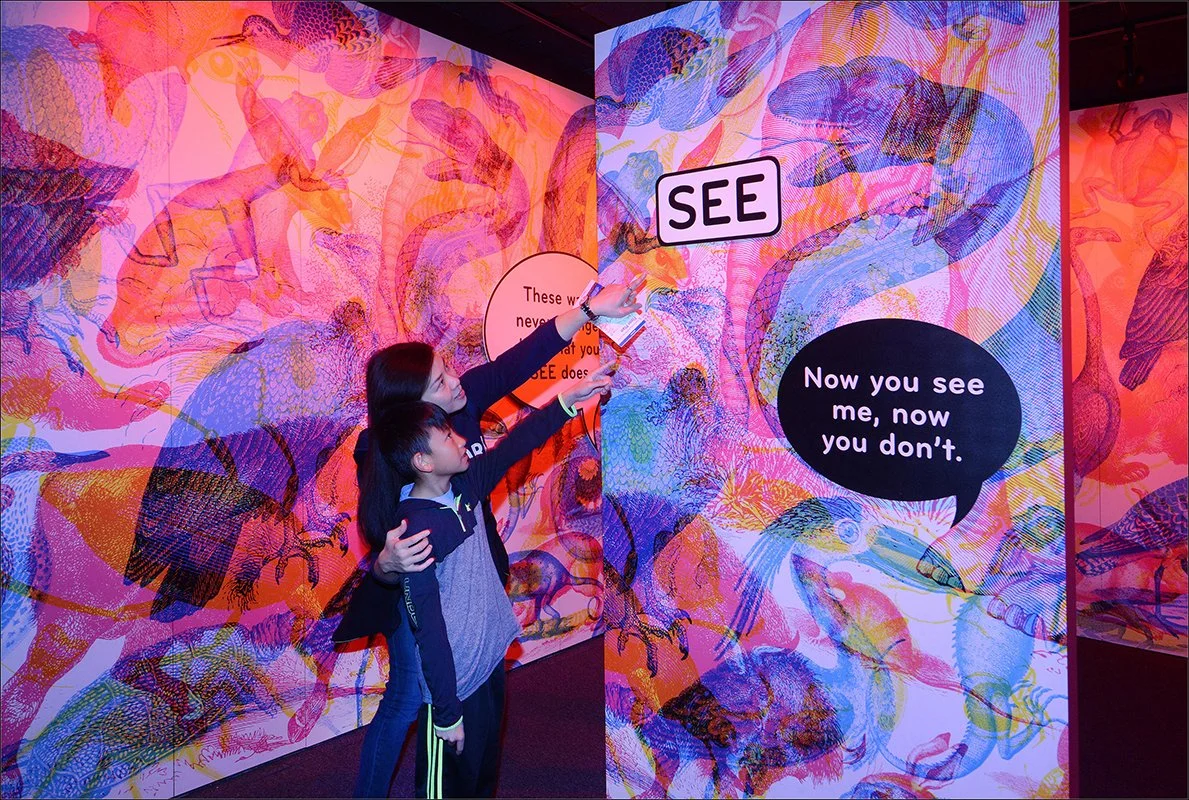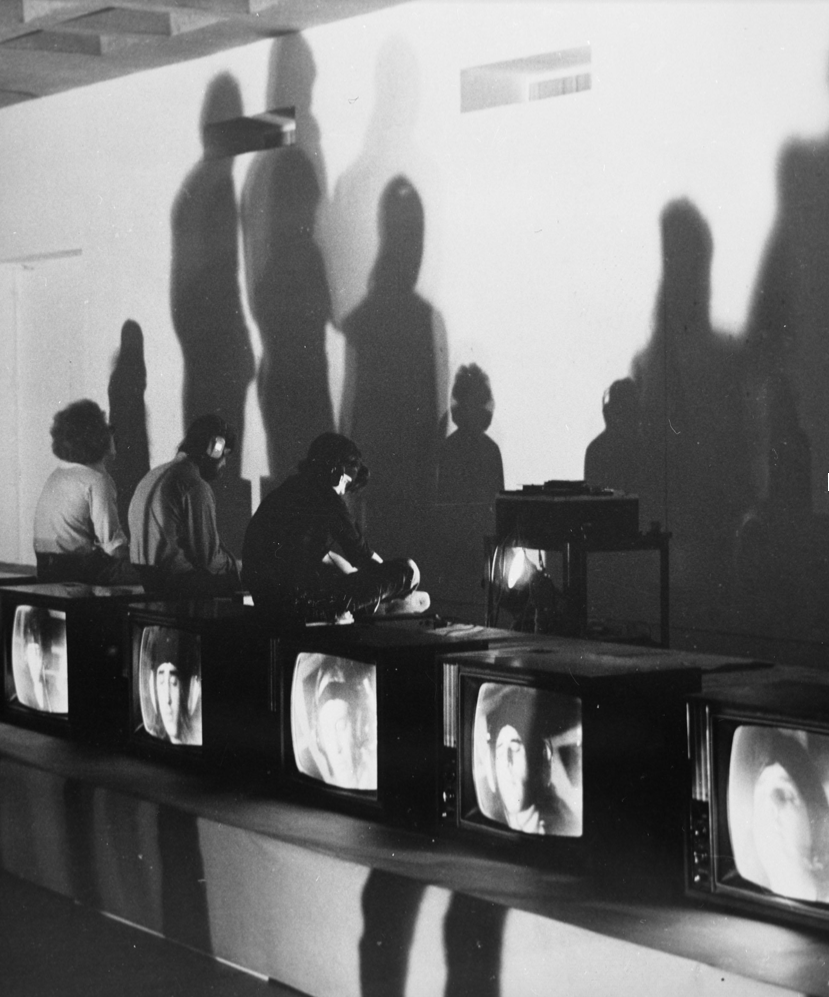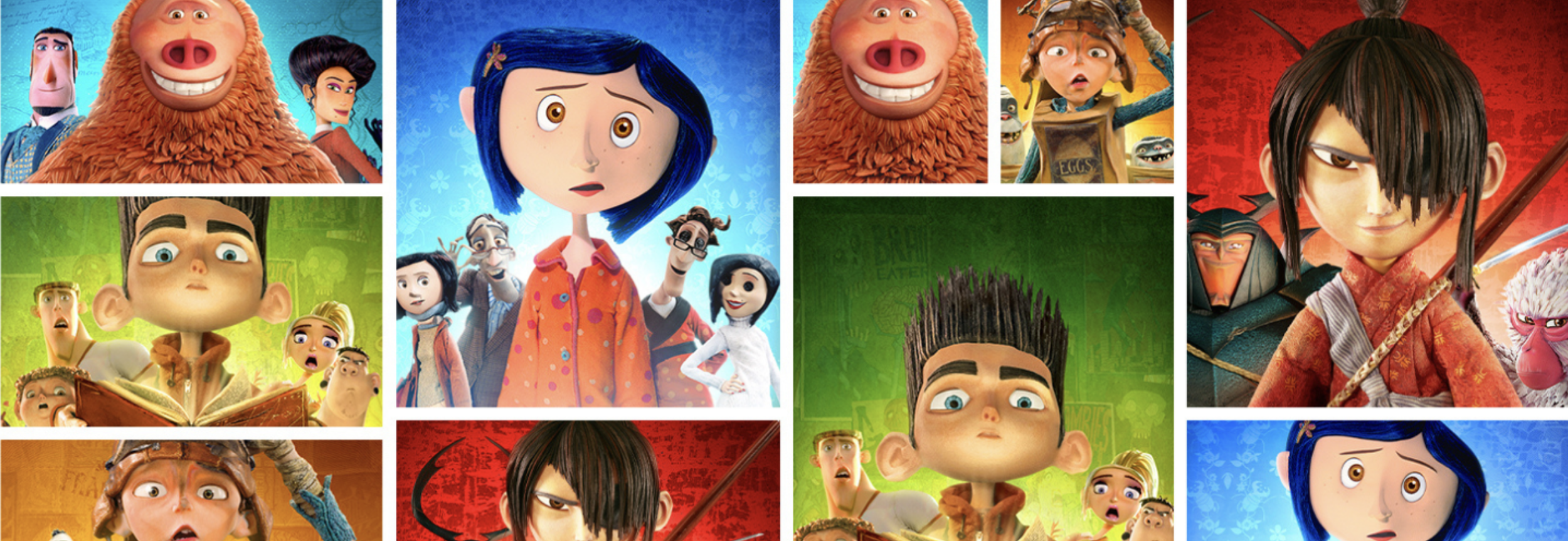TODAY, GOOD UX DESIGN MEANS GOOD ATTENDANCE
It is difficult to define user experience (UX) and experience design in a manner that effectively describes the discipline. Given that UX is so complex, especially in a changing post-covid world,the role of UX is often redefined within the museum setting. Designers in today’s world must discover new ways to evolve their UX alongside the external challenges that they encounter in the real world. Since the Covid pandemic began, many museums have adapted their exhibits to be accessible online, allowing for continued traffic and artist exposure— from the living room couch rather than in person. Although these online exhibitions were a great development for museum participation during the pandemic, it can be argued that the continuation of these online spaces can serve as both an advancement and a barrier for museums in a post-covid world.
Figure 1: Infographic source: Author
Virtual museum exhibits offer many accommodations and opportunities, but rather than being privileged to travel, the visitor is now privileged by having internet access. It is apparent that some museums are more comfortable in creating innovative and exciting virtual exhibits than others, and this often means that they have studied UX theory and implemented it into their own practices. Museums usually partake in an exhaustive amount of planning to effectively execute an in-person exhibit. The development of virtual museum planning and exhibitions has relieved some of this pressure to perform.
Nielsen’s 10 Usability Heuristics for User Interface Design is an important resource for anyone working in the digital museum space, notably placing emphasis on keeping users informed, engaged, interested, and organized. Usability is an attempt to replicate the experience of an in-person museum experience. Although in-person and online exhibitions differ in their execution, they both have the same goals of achieving clarity, context, and curiosity of their audience. It is crucial to take the demographics of their audience into consideration to make decisions about how the exhibits are displayed to be able to appeal to a certain group of visitors. Without consideration and extensive planning, a lack of viewership would result and the exhibit would ultimately fail. Therefore, both the physical museum exhibit as well as the virtual require careful thought and consideration. (Williams, 2022)
Since the pandemic began, adjustments have been made to meet the needs of both museums and their audiences. Museum directors and exhibit designers were, and continue to be, faced with a challenge concerning how to resume attendance in museums in a changing world. Besides the obvious concerns about maintaining sanitary conditions and creating an environment where people feel protected, it became necessary for museums to create new and exciting in-person exhibits that contained never-seen-before UX to boost attendance and participation. Design within UX is efficient if it creates a space where users can explore and create their own paths according to their emotions and behaviors. A museum demonstrating digital readiness and innovation in its exhibition spaces defines its maturity and ability to maintain relevance.
HOW ARE MUSEUMS DOING DIGITALLY?
The Knight Foundation conducted a survey with the American Alliance of Museums to capture anonymous data from 480 museums across all 50 states. (Figure 1) Of this data, 30% are characterized as art museums, 38% as historic institutions and sites, 11% as science museums and others, and 65% of the total institutions who responded were defined as small (with an annual budget of $5 million or less or have less than 49 employees). This data, collected in 2019, gives a picture of the status of digital readiness and innovation in the field prior to the pandemic. It also gives a point of reference to gauge changes since 2020.
This survey demonstrates that “dedicated digital staffing” is severely limited, meaning that half of the institutions have either no staff dedicated to digital media or that the department was run by a single individual. (Figure 1) It also found that 31% of museums admitted they had no digital strategy, and 29% claimed that this was a process in development. This means that only 25% have a planned or implemented digital strategy for their strategic plan. In addition, 41% of museums do not have any defined goals, KPIs or outcome measures for digital projects and less than half report that digital leaders are a part of senior leadership teams. (Figure 2 & 3) Lastly, 54% of museums reported capturing basic feedback or demographics from their audience while only 18% use this data to shape their exhibits for the future. (Knight Foundation, 2022)
Figure 2 Source: The Knight Foundation
Figure 3 Source: The Knight Foundation
Digital Literacy informs Public Expectations
Digital literacy has advanced alongside the rapid advancement of technology. These changes create a sense of urgency for museums to adapt to using digital technologies to provide exciting experiences to visitors. By doing this, museums are spreading their digital literacy to visitors, and all individuals benefit from the new technology and knowledge acquired. After the pandemic hit, museums were forced to minimize exposure of the virus by temporarily shutting down. During the pandemic, there was a switch from physical exhibitions and activities to digital ones. The comfort that digital exhibitions provided to visitors was effective—it allowed for viewership from home and was typically free.
The digital technology not only made it easier for visitors to browse content, but it provided a new UX design flow that was more than just a physical, static display of artifacts and artworks. An advantage of digital artifacts is that they have the ability to be displayed without the time constraints of a temporary exhibit, meaning that they can live in the digital realm for visitors to access whenever they please.
In 2022 museums are open and attempting to regain in-person attendance. It is imperative for museums to take advantage of the new technology that was developed and implemented during the pandemic to be able to incorporate it into their in-person exhibits to drive attendance back to the museum and get people off of their couches. (Huang et al., 2022)
As museums move to reimagine their institutions for a changed future, they are looking to create new pathways for their digital footprint to expand—using the knowledge they have gained alongside the digital exhibitions that were created during the pandemic. New interpretations of digital readiness will likely emerge in the museum space.
The inclusion of digital projects is occurring within organizations as they attempt to learn what interests their audiences and to be able to make strategic decisions about how to proceed in a manner that best represents their missions and values.
Funding Innovative Digital Design: five cases
Since 2017, The Knight Foundation has invested over $15 million to support digital transformation in museums throughout the entire United States by supporting emerging technology, technology staffing, and support for practitioners to share their best practices and build strong relationships with the community. (Knight Foundation, 2022)
$750,000 was given to five arts institutions in 2019 by The Knight Foundation for their dedication to using immersive technology in the arts. The organizations that were selected were the American Museum of Natural History, The Colored Girls Museum with the Center for Digital Humanities at the University of Arizona, the Japanese American Museum of San Jose, the Museum of Art and Design at Miami Dade College, and the Museum of the Moving Image (MoMI) and Scatter. Although the grant money was given prior to the pandemic, the organizations continued to create innovative experiences concerning UX in the arts.
The American Museum of Natural History’s project explored:
“how immersive technology and data visualization can combine to give museum audiences more context for exhibited objects: The museum will develop workflows and open-source software to transform collections data into interactive experiences; experiment with how the software can support VR and other immersive technologies; and make recommendations to cultural institutions that would like to implement similar experiences for their audiences.” (Knight Foundation, 2022)
Their current traveling exhibit known as Our Senses: An Immersive Experience utilizes AI to create hands-on experiences made of distorted 3D elements to help explain the neural pathways of different species.
The American Museum of Natural History: Our Senses
The American Museum of Natural History: Our Senses
The project at The Colored Girls Museum with the Center for Digital Humanities at the University of Arizona established:
“a model for collaboratively producing VR/AR museum experiences to expand and engage audiences: The institutions will partner to create an augmented reality enhanced virtual museum experience that connects a dynamic group of artists, educators and technologists with everyday women of the African diaspora. The project will produce a series of real and virtual exhibits around the world, leveraging the power of immersive, interactive experiences to engage visitors with the life experiences of women and girls of the African diaspora.” (Knight Foundation, 2022)
Their current experience known as The Colored Girls Museum VR provides a VR experience where users can view museum collections in a 3D space to better visualize and understand the pieces.
The Japanese American Museum of San Jose’s project leveraged:
“augmented reality and art, enhancing the museum’s connections with the surrounding community: The museum will do outreach and conduct workshops with local community members, incorporating their ideas and aspirations into an augmented reality experience that reveals the multi-ethnic history and culture of San Jose’s Japantown district.” (Knight Foundation, 2022)
Their current project known as The Hidden Histories of San Jose Japantown uses augmented reality, art, and local history and culture to create an exploration of the “hidden” stories of the community.
The Japanese American Museum of San Jose:The Hidden Histories of San Jose Japantown
The Museum of Art and Design at Miami Dade College focused on:
“developing the skills and capacity for a sustained exploration of the intersection of art, social justice and immersive technology: Through Forensic Architecture: True to Scale — its first exhibition to implement immersive technology — MOAD will create a study center; pilot ongoing curricula; and develop a tactical playbook for the continued critical and creative incorporation of immersive technology into museum programming, displays and outreach opportunities.” (Knight Foundation, 2022)
Their 2021 exhibit known as The Body Electric uses film and the presence of technology as a fusion of body and screen.
MOAD: The Body Electric
The Museum of the Moving Image’s project explored:
“how technological platforms of the future can teach and encourage social engagement and open dialogue in museum contexts: Scatter will produce a virtual reality documentary experience, created with their volumetric filmmaking technology, Depthkit. The experience will be presented as an exhibition and residency at MoMI. The project will allow local community members to contribute their stories and 3D likeness to the experience onsite at the Museum on an ongoing basis.” (Knight Foundation, 2022)
Their current exhibit known as LAIKA: Life in Stop Motion is an interactive animation that allows visitors to experiment and create their own short films to share and post online.
MOMI: LAIKA: Life in Stop Motion
Museums depend on UX for Survival
Consumer satisfaction is crucial to the success of museum exhibits, especially ones that are trying to stand out. Not only are the museums competing digitally, but they are also competing with one another in a competitive tourism industry. In a world where social media is a heavy influence on decision-making, museums are presented with an opportunity to appeal to specific audiences through their exhibits. Social media is a large driving force for visitor attendance in the way that pictures and interactions are encouraged. Given the interactive nature of these exhibits, and the inherent desire of viewers to take an Instagrammable photo to have bragging rights, the UX design becomes highly effective and is able to survive for a reasonable amount of time. The museums that house exhibits similar to those previously mentioned have a competitive advantage and are able to leverage their success in a way that studies consumer patterns and allows them to better understand what type of exhibits the visitors want, and to see what drives attendance and engagement within their corporation. (Faerber et al., 2021)
Further Research
In part two of this article, interviews with museum workers and managers in will be analyzed for statistics concerning attendance, engagement, impact, and current “innovative” technologies that are promoting the development of new UX design flows.
-
Al-Hajji, Zainab. “Applying User Experience (UX) Design in Interior Space for Art, Science Museums, and Learning Environments.” ProQuest Dissertations Publishing, 2017. https://cmu.primo.exlibrisgroup.com/permalink/01CMU_INST/8lb6it/cdi_proquest_journals_1972896704.
“American Museum of Natural History: Home,” American Museum of Natural History, Accessed October 22, 2022. https://www.amnh.org/.
Barr, Chris. “Measuring the Digital Journeys of Museums.” Knight Foundation. October 16, 2020.https://knightfoundation.org/articles/measuring-progress-of-the-digital-journeys-of-museums/.
“Digital Readiness and Innovation in Museums.” Knight Foundation. Accessed September 27, 2022. https://knightfoundation.org/reports/digital-readiness-and-innovation-in-museums/.
Faerber, Lea Susanne, Dennis C. Ahrholdt, Schnittka Oliver, and Rezvani Zeinab. "Visitor Characteristics Matter: How the Positive Impact of Visit Duration on Visitor Satisfaction at Visitor Attractions is Moderated." The Journal of Business Economics 91, no. 3 (04, 2021): 333-351. doi:https://doi.org/10.1007/s11573-020-01002-z. https://www.proquest.com/scholarly-journals/visitor-characteristics-matter-how-positive/docview/2504629236/se-2.
Huang, Pin-Chia, Lisa Y. Chen, I-C Li, and Cheng-Hsiung Shih. "THE IMPACT OF MUSEUM PRACTITIONERS' INFORMATION LITERACY ON THE EFFECTIVENESS OF EXHIBITION DIGITIZATION IN THE POST-PANDEMIC ERA." International Journal of Organizational Innovation (Online) 14, no. 4 (04, 2022): 130-149. https://www.proquest.com/scholarly-journals/impact-museum-practitioners-information-literacy/docview/2653588561/se-2.
“Japanese American Museum of San Jose: Home,” Japanese American Museum of San Jose, Accessed October 22, 2022, https://www.jamsj.org/.
Konstantakis, Markos, Yannis Christodoulou, Georgios Alexandridis, Alexandros Teneketzis, and George Caridakis. "ACUX Typology: A Harmonisation of Cultural-Visitor Typologies for Multi-Profile Classification." Digital 2, no. 3 (2022): 365. doi:https://doi.org/10.3390/digital2030020.https://www.proquest.com/scholarly-journals/acux-typology-harmonisation-cultural-visitor/docview/2716514280/se-2.
“Museum of Art and Design Miami Dade College: Home,” MOAD, Accessed October 22, 2022, https://moadmdc.org/.
“Museum of the Moving Image: Home,” Museum of the Moving Image, October 17, 2022. https://movingimage.us/.
Nesset, Valerie, Elisabeth C. Davis, Owen Stewart-Robertson, and Brice Bible J. "Bonded Design in the Virtual Environment: The Transition of a Participatory Design Methodology." Journal of Documentation 78, no. 3 (2022): 513-528. doi:https://doi.org/10.1108/JD-05-2021-0095. https://www.proquest.com/scholarly-journals/bonded-design-virtual-environment-transition/docview/2641234933/se-2.
“Shaping the Future of Technology in Museums: Knight Invests $750,000 in Five Experiments Using Immersive Technology in the Arts.” Knight Foundation. Accessed September 27, 2022. https://knightfoundation.org/press/releases/shaping-the-future-of-technology-in-museums-knight-invests-750000-in-five-experiments-using-immersive-technology-in-the-arts/.
Steane, Jamie, Jo Briggs, and Joyce Yee. "T-Shifting Identities and Practices: Interaction Designers in the Fourth Industrial Age." International Journal of Design 14, no. 3 (12, 2020): 85-96.https://www.proquest.com/scholarly-journals/t-shifting-identities-practices-interaction/docview/2478654515/se-2.
“The Colored Girls Museum: Home,” The Colored Girls Museum, Accessed October 22, 2022, http://thecoloredgirlsmuseum.com/.
Williams, Joseph. “Day or Night at the Museum: A UX Analysis of Virtual Exhibits.” Journal of technical writing and communication 52, no. 2 (2022): 166–181. https://cmu.primo.exlibrisgroup.com/permalink/01CMU_INST/8lb6it/cdi_scopus_primary_2015052021.


